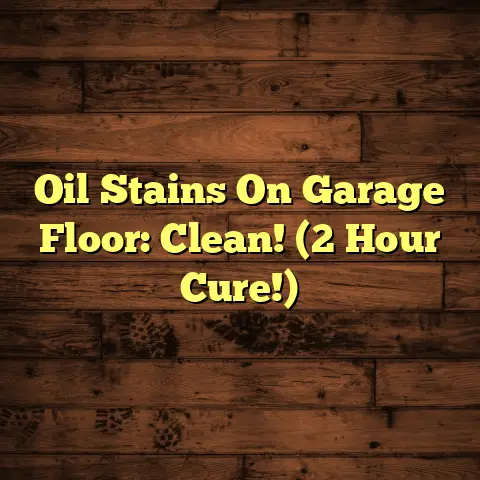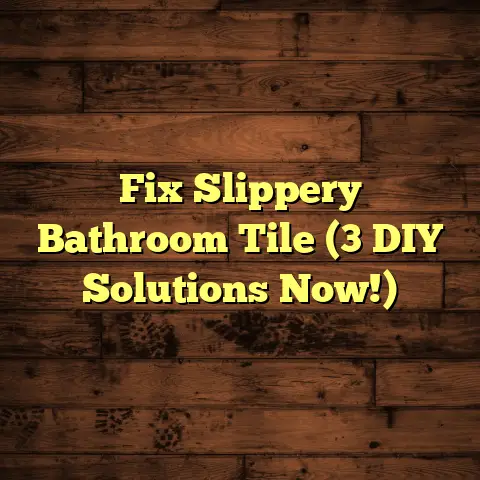Rubber Mats Over Carpet: Effective? (3 Subfloor Fails!)
Flooring is more than just something to walk on; it’s the foundation of your space’s comfort, safety, and style.
And when it comes to versatile flooring solutions, rubber mats are often touted as a “must-have.”
From home gyms to bustling kitchens and muddy entryways, they seem to pop up everywhere.
Why? Well, they’re durable, slip-resistant, and easy to clean.
But what about the increasingly popular trend of placing rubber mats over carpet?
Does it really work?
Is it a flooring match made in heaven, or a disaster waiting to happen?
That’s what we’re diving into today.
We’ll explore the benefits of rubber mats, the appeal of layering them over carpet, and, most importantly, the potential pitfalls that can lead to what I call “subfloor fails.”
Trust me, I’ve seen it all, and I’m here to help you avoid costly mistakes.
So, grab a cup of coffee, settle in, and let’s get started!
Section 1: Understanding Rubber Mats and Their Benefits
First things first, let’s talk about what rubber mats are.
Essentially, they’re floor coverings made from rubber – simple, right?
But there’s more to it than meets the eye.
You’ve got your interlocking mats, perfect for creating larger, customizable surfaces, and rolled rubber, ideal for covering expansive areas like gyms.
And then there’s the material itself: natural rubber, sourced from rubber trees, and synthetic rubber, created from petroleum byproducts.
Each has its own pros and cons in terms of durability, cost, and environmental impact.
Benefits of Rubber Mats
Now, why are rubber mats so popular? Let’s break down the key advantages:
Safety: This is a big one.
Rubber mats offer excellent slip resistance, which is crucial in areas prone to spills or moisture.
They also provide cushioning, reducing the risk of injuries from falls.Ease of Cleaning: Seriously, these things are a breeze to clean.
Most are water-resistant, so you can simply wipe up spills with a damp cloth.
For tougher messes, a mild detergent usually does the trick.
Avoid harsh chemicals, as they can damage the rubber.Versatility: As I mentioned earlier, rubber mats can be used in a variety of settings.
Homes, gyms, commercial spaces – you name it.
They’re adaptable to different needs and environments.Comfort: Standing on hard floors for extended periods can be tough on your feet and joints.
Rubber mats provide impact absorption, making it more comfortable to stand and work.
Popular Uses
I’ve seen rubber mats used in countless ways over the years.
Here are a few common applications:
-
Gyms: Obvious, right? They protect floors from heavy equipment and provide cushioning for workouts.
-
Kitchens: They offer a non-slip surface and protect floors from spills and stains.
-
Entryways: They trap dirt and moisture, preventing it from being tracked throughout the house.
-
Workshops: They provide a durable and comfortable surface for working on projects.
In each of these scenarios, rubber mats offer a practical and effective flooring solution.
Section 2: The Appeal of Placing Rubber Mats Over Carpet
Okay, so we know rubber mats are great.
But why the trend of putting them over carpet?
Let’s dig into the reasons behind this flooring fad.
Trends in Flooring
Layering rugs over carpet has been a decorating trick for years, but rubber mats are a newer addition to the mix.
I’ve noticed it becoming increasingly popular, especially in homes and apartments where people want to protect their existing carpet without going through the hassle of a full replacement.
Aesthetic Variety
Let’s be honest, carpet can be a bit… boring.
Rubber mats can add a pop of color, texture, and visual interest to a carpeted area.
Think about a sleek black rubber mat in a home gym, contrasting with the beige carpet underneath.
It can really elevate the look of the space.
Practical Reasons
But it’s not just about aesthetics.
There are some very practical reasons why people choose to place rubber mats over carpet:
- Cushioning for Activities: If you’re doing workouts or other activities on carpet, a rubber mat can provide extra cushioning and support.
- Protection of Carpets: This is a big one.
Rubber mats can shield carpets from spills, stains, and wear and tear, especially in high-traffic areas. - Ease of Installation and Removal: Unlike replacing an entire carpet, placing a rubber mat is quick and easy.
And when you’re done with it, you can simply roll it up and store it away.
So, on the surface, it seems like a win-win situation.
But hold on tight because we’re about to dive into the dark side of this trend: subfloor fails.
Section 3: The Reality of Subfloor Fails
Alright, let’s get down to the nitty-gritty.
Subfloor fails are the hidden problems that can arise when you place rubber mats over carpet.
And trust me, these problems can be a real headache.
What do I mean by “subfloor fails”?
Well, the subfloor is the layer beneath your finished flooring.
It provides a solid, level base.
When you cover carpet with a rubber mat, you’re essentially creating a closed environment that can trap moisture, promote wear and tear, and even create safety hazards.
Here are three common subfloor fails I’ve encountered over the years:
Fail #1: Moisture Issues
This is the most common and potentially the most damaging issue.
The combination of rubber mats and carpet can trap moisture, leading to mold and mildew growth.
Think about it: carpet is porous and absorbs moisture.
Rubber mats, on the other hand, are non-porous and prevent moisture from evaporating.
So, any spills, humidity, or even just moisture from your shoes can get trapped between the mat and the carpet, creating a breeding ground for mold and mildew.
Environments Where This Is Common:
- Basements: Basements are notoriously damp, making them prime locations for moisture-related issues.
- Kitchens: Spills are inevitable in kitchens, and the combination of moisture and warmth can accelerate mold growth.
- Bathrooms: Similar to kitchens, bathrooms are prone to moisture from showers and sinks.
I remember one client who placed rubber mats in their basement gym.
A few months later, they noticed a musty smell and discoloration on the carpet underneath the mats.
When I pulled up the mats, we found a significant mold problem.
The cost to remediate the mold and replace the carpet was far greater than the cost of the rubber mats themselves.
Statistics and Data:
According to the EPA, mold growth can occur on surfaces with excessive moisture accumulation.
Carpets, especially those covered with non-breathable materials like rubber mats, are particularly vulnerable.
EPA Mold Resources
Prevention Tips:
- Choose Breathable Mats: Look for rubber mats with ventilation holes or channels to allow for airflow.
- Use a Moisture Barrier: Consider placing a moisture barrier between the carpet and the rubber mat.
- Regularly Inspect: Lift the mats periodically to check for moisture or discoloration.
- Ventilate: Ensure adequate ventilation in the room to reduce humidity levels.
- Dehumidifier: Use a dehumidifier in damp environments like basements.
Fail #2: Wear and Tear of Carpet
Even if you manage to avoid moisture issues, rubber mats can still contribute to uneven wear and tear on the carpet underneath.
Think about areas with high foot traffic.
The rubber mat will protect the carpet directly underneath it, while the surrounding carpet will be exposed to wear and tear.
This can create a noticeable difference in appearance over time, leading to an uneven and unsightly look.
Implications of This Wear:
- Increased Maintenance Costs: You may need to clean or repair the surrounding carpet more frequently to maintain a consistent appearance.
- Premature Carpet Replacement: Uneven wear can shorten the lifespan of your carpet, requiring you to replace it sooner than expected.
I had another client who placed a rubber mat in their entryway to protect the carpet from dirt and moisture.
While the mat did its job, the surrounding carpet became noticeably worn and faded over time.
The result was a patchwork effect that looked worse than if they had simply left the carpet unprotected.
Statistics and Data:
According to the Institute of Inspection, Cleaning and Restoration Certification (IICRC), uneven wear patterns are a common cause of carpet degradation.
IICRC Standards
Prevention Tips:
- Rotate Mats: Rotate the mats regularly to distribute wear evenly.
- Use a Carpet Pad: Place a carpet pad underneath the mat to provide extra cushioning and support.
- Choose a Mat with a Similar Pile Height: Select a mat with a pile height that is similar to the surrounding carpet to minimize the difference in wear.
- Regular Cleaning: Clean the surrounding carpet regularly to remove dirt and debris that can contribute to wear.
Fail #3: Safety Hazards
Finally, let’s talk about safety.
While rubber mats are generally slip-resistant, placing them over carpet can actually create new safety hazards.
If the mats shift or slide, they can create a tripping hazard, especially in busy or active environments.
The combination of the soft carpet underneath and the rigid rubber mat on top can also create an unstable surface, making it easier to lose your balance.
Insights:
- Slipping: The rubber mat may slide on the carpet, especially if it’s not properly secured.
- Tripping: The edge of the mat may curl up or become uneven, creating a tripping hazard.
- Unstable Surface: The combination of the soft carpet and the rigid mat can create an unstable surface, making it easier to lose your balance.
I once visited a commercial space where rubber mats had been placed over carpet in a high-traffic hallway.
I noticed several employees tripping over the edges of the mats, which had shifted and curled up over time.
It was a clear safety hazard that needed to be addressed immediately.
Statistics and Data:
The National Safety Council reports that falls are a leading cause of injury in the United States.
Unstable surfaces, such as those created by improperly installed or maintained flooring, can contribute to fall-related injuries.
National Safety Council Fall Prevention
Prevention Tips:
- Secure the Mats: Use double-sided tape or carpet adhesive to secure the mats to the carpet.
- Choose Mats with Beveled Edges: Select mats with beveled edges to reduce the risk of tripping.
- Regularly Inspect: Inspect the mats regularly to ensure they are properly secured and in good condition.
- Use Warning Signs: Place warning signs near the mats to alert people to the potential tripping hazard.
Section 4: Conclusion
So, there you have it.
Rubber mats can be a great flooring solution, offering safety, comfort, and versatility.
But placing them over carpet can lead to some serious subfloor fails, including moisture issues, wear and tear, and safety hazards.
Before you decide to place rubber mats over carpet, I urge you to weigh your options carefully.
Consider the specific conditions of your space, the activities you perform there, and the potential risks involved.
If you’re concerned about moisture, choose breathable mats or use a moisture barrier.
If you’re worried about wear and tear, rotate the mats regularly and use a carpet pad.
And if you’re concerned about safety, secure the mats properly and choose mats with beveled edges.
Ultimately, the decision is yours.
But by understanding the potential pitfalls, you can make an informed choice that protects your floors, your health, and your safety.
And if you’re ever unsure, don’t hesitate to consult with a professional flooring contractor.
We’re here to help you make the best decision for your space.
Thanks for reading, and happy flooring!





